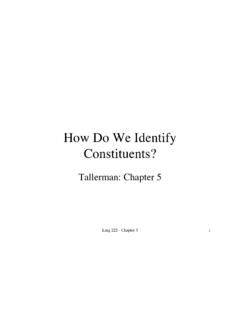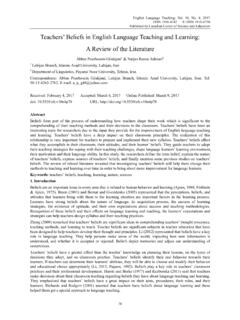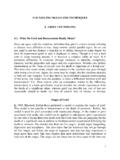Transcription of Change and Higher Education - ERIC
1 811 Change and Higher Education : A Multidisciplinary Approach Julia Storberg-Walker Richard Torraco University of Nebraska Higher Education now finds itself in a new era and environment in which it is confronted with an array of challenges and forces for Change . This paper identifies the key forces for Change in Higher Education , assesses these forces using an established Change model (the action research model), and illustrates how Change literature from management, human resource development, and economics have the potential to contribute to successful Change management in Higher Education environments. Keywords: Higher Education , Change , Action Research Given a long history of relative stability and steady growth, Higher Education now finds itself in a new era and environment in which it is confronted with an array of challenges and forces for Change .
2 Significant Change at this point in the evolution of Higher Education appears eminent due to powerful environmental forces related to technology, competition, and the workplace/workforce (see Kezar and Eckel, 2003; Welsh and Metcalf, 2003; Kemelgor, Johnson and Srinivasan, 2000). These new forces are causing significant shifts directly impacting Higher Education goals, processes, and decision-making. Despite the likelihood of substantial Change that has swept through most other sectors of the economy in recent years, some doubt the ability of Higher Education to deal with this magnitude of Change . Arthur Levine (2003) laments that providers of Higher Education will ignore or move glacially as Higher Education decision making is prone to do, into the digital era or that traditional Higher Education will rush into, or worse yet, will be pushed headlong into the new digital economy and abandon what is sacred about Higher Education , those things that no other social institution is capable of providing (p.)
3 26). This paper examines Change in Higher Education at a critical point in its evolution. To organize the inquiry, we use an established Change model (the action research model) that is widely used for planned Change processes. Action research has been theoretically and empirically validated in traditional organizational forms. We use the model to identify where (at what points in the Change process) and why (what are the substantive differences between Higher Education and traditional firms) planned Change in Higher Education may be more challenging than in traditional firms. From that basis, we then use the model to illuminate the differences and gaps between traditional Change management and the nature of Change management in Higher Education environments.
4 The Action Research Model of Planned Change Since the 1940s, studies have found that research needed to be closely linked to action if organization members were to use it to manage Change (Cummings & Worley, 1993, p. 8). These findings laid the foundation for contemporary organization development and have guided the theory and practice of planned Change for the past 60 years. Action research applies behavioral science knowledge to organizational problems, seeks involvement of organizational members at each stage of the process, and provides feedback throughout the process in order to adapt and recalibrate the action plan. The specific steps in action research have been described differently (see, for example, Shepard (1960), Cummings & Worley (1993), French & Bell (1999), and Rothwell, Sullivan & McLean (1995)): for this paper, Shephard s recursive four-phased model is selected because it is the most generic model of planned Change .
5 This model can incorporate the more detailed elements from the other action research models and it provides the minimal requirements for planned Change through action research. Shephard s (1960) model highlights the relations among goals (objectives), planning, and action (French & Bell, 1999, p. 132). The central focus is research with the purpose of informing current and future action. The steps are 1) identify the objective; 2) plan the Change process; 3) take action; 4) evaluate; and then repeat. The outcome of evaluation may lead to new planning (step 2 in the sequence) or lead to new objectives (step 1 in the sequence). The process is continual, iterative, and is grounded by organizational objectives. We use Shepard s (1960) four steps to illuminate the unique challenges for planned Change initiatives in the Higher Education environment.
6 Copyright 2004 Julia Storberg-Walker & Richard Torraco 37-3 812 The paper is organized in three sections. The first section provides the background of the contemporary Higher Education environment. Two broad categories are discussed: 1) the key factors shaping the environment of Higher Education , and 2) the forces and catalysts for Change . Within each category, we illustrate how these factors and forces can shape and influence Shepard s (1960) planned Change process. The key factors effecting Higher Education include 1) governance structures; 2) diverse stakeholders and constituents; and 3) culture. These factors serve as important conduits and mediators of how any planned Change process would occur in institutions of Higher Education . The forces and catalysts for Change include 1) fiscal and budgetary constraints; 2) rapid growth in the use of information technology; and 3) market forces including the increasing competition for students.
7 The second part of the paper offers select theories and concepts found within Change literature from a variety of disciplines. Scholarship on Change from management, HRD, and economics were selected to illustrate the potential contributions of these disciplines. The review is not meant to be comprehensive; rather, the authors provide examples from these disciplines that directly relate to the key factors of the Higher Education environment. The third and final component of this paper seeks to reconcile the Higher Education -specific Change models reported in the literature with the examples presented in part two . Specifically, we seek a better understanding of the dimensions of Change in Higher Education that are reflected in the following research questions: 1) how do the factors of and forces on Higher Education impact the planned Change process?
8 ; 2) what do other disciplines offer that may inform the planned Change process for Higher Education ?; and 3) how can HRD effectively advise Higher Education institutions on Change ? Through this analysis we hope to gain a better understanding of the ways in which institutions of Higher Education experience Change and, using the lens of Change theory from management, HRD, and economics, how Higher Education might more effectively manage Change in today s environment of turbulent, more market-driven culture. Change A Higher Education Perspective Key Factors in Higher Education Several unique factors permeate the Higher Education environment which are integral to the nature and purpose of Higher Education . These factors include organizational leadership and governance structures, diverse stakeholders and constituents of Higher Education , and institutional culture (Duderstadt & Womack, 2003; Welsh and Metcalf, (2003); Kezar and Eckel, 2002).
9 Organizational leadership, diversity, and culture substantially impact all four steps of Shephard s (1960) model of planned Change . Institutional leadership and governance. Duderstadt and Womack (2003) discuss institutional governance in Higher Education in terms of a process that is shared among key constituencies a governing board of lay trustees or regents as both stewards for the institution and protectors of the broader public interest, the faculty as those most knowledgeable about teaching and scholarship, and the university administration as leaders and managers of the institution. In short, the shared governance in Higher Education allocates the tasks of leading and managing the institution to the administration, academic matters to the faculty, and public accountability and stewardship to the governing board.
10 From this perspective, it is clear that the leadership and governance structure of Higher Education will substantially shape any Change process that begins with identifying and building consensus on objectives. The governance structure of Higher Education , combined with numerous institutional leaders, managers, and academics, resembles more like the governance and leadership of democratic country than the governance and leadership of a typical business organization. Organizational politics, coalition building, and the differential power of both leaders and constituents play a much greater role in Higher Education organizations than in the traditional view of the firm. By applying Shephard s (1960) model of planned Change to this reality, we find that the first step of the process creating and agreeing on objectives can be seen as difficult, if not problematic, for Higher Education providers.


















